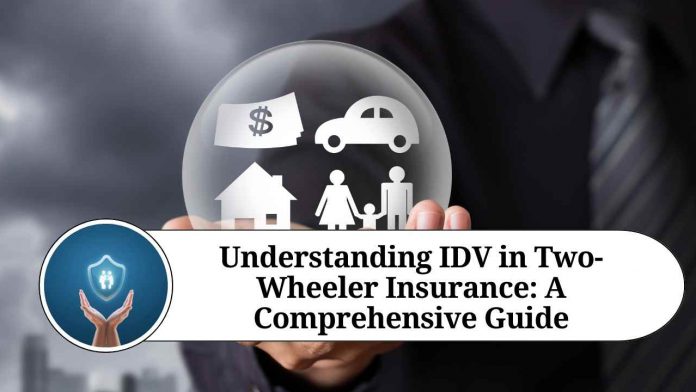Introduction
When it comes to protecting your two-wheeler from unforeseen risks, having the right insurance coverage is essential. One crucial aspect of two-wheeler insurance is the Insured Declared Value (IDV). Understanding IDV is vital as it directly impacts the premium you pay and the amount you receive in case of theft or total loss. In this comprehensive guide, we will delve into what IDV is and why it matters in two-wheeler insurance.
What is IDV?
Insured Declared Value (IDV) is the maximum sum assured fixed by the insurance company during the policy period. It represents the current market value of your two-wheeler after considering depreciation. In simple terms, it is the approximate amount that the insurer would pay you if your two-wheeler is stolen or suffers total damage beyond repair.
Calculating IDV: The IDV of your two-wheeler is calculated based on the manufacturer’s listed selling price and the age of the vehicle. The formula used to determine IDV is:
IDV = Manufacturer’s Listed Selling Price – Depreciation
The depreciation is calculated based on the age of the two-wheeler as follows:
- Up to 6 months: 5% depreciation
- Over 6 months to 1 year: 15% depreciation
- Over 1 year to 2 years: 20% depreciation
- Over 2 years to 3 years: 30% depreciation
- Over 3 years to 4 years: 40% depreciation
- Over 4 years to 5 years: 50% depreciation
After 5 years, the IDV is determined mutually by the insurer and the policyholder.
Why is IDV important?
Premium Calculation: The IDV of your two-wheeler directly affects the premium amount you pay for your insurance policy. Higher IDV leads to a higher premium, while a lower IDV results in a lower premium. It’s crucial to strike the right balance between IDV and premium to ensure you have adequate coverage without overpaying.
Coverage for Total Loss: In the unfortunate event of your two-wheeler being stolen or damaged beyond repair, the insurer will compensate you based on the IDV. It is essential to understand that IDV represents the maximum amount you can claim in such scenarios. Therefore, ensuring the IDV is set correctly helps you receive an appropriate payout to replace your two-wheeler.
Claim Settlement: During claim settlement, the IDV is considered to determine the compensation amount. If the IDV is set too low, you may receive inadequate compensation. On the other hand, if the IDV is set too high, you may end up paying higher premiums without proportionate benefits during claim settlement.
Tips for managing IDV effectively:
Stay updated with the market value: Keep track of the current market value of your two-wheeler to ensure your IDV reflects its true worth. This will help you make informed decisions while renewing your policy or purchasing a new one.
Balance IDV and premium: Assess your requirements and budget to strike a balance between a higher IDV for comprehensive coverage and a premium that fits within your financial means.
Consult with insurance experts: Seek guidance from insurance experts or your insurance provider to understand the ideal IDV for your two-wheeler. They can provide personalized advice based on your specific needs.
Conclusion
Insured Declared Value (IDV) plays a crucial role in two-wheeler insurance as it determines the maximum compensation you can receive in case of theft or total loss. Understanding the concept of IDV, its calculation, and its significance will help you make informed decisions while purchasing or renewing your two-wheeler insurance policy. By managing your IDV effectively, you can ensure that your two-wheeler is adequately protected while maintaining a balance between coverage and affordability.
Read more useful content:
Frequently Asked Questions (FAQs)
Q1: What does IDV stand for in two-wheeler insurance?
A1: IDV stands for Insured Declared Value.
Q2: What does IDV represent in two-wheeler insurance?
A2: IDV represents the approximate current market value of a two-wheeler after factoring in depreciation. It is the maximum sum assured fixed by the insurance company for the policy period.
Q3: How is IDV calculated in two-wheeler insurance?
A3: IDV is calculated by subtracting the depreciation from the manufacturer’s listed selling price. The depreciation percentage depends on the age of the two-wheeler.
Q4: How does IDV affect the premium in two-wheeler insurance?
A4: The IDV directly influences the premium amount. A higher IDV leads to a higher premium, while a lower IDV results in a lower premium.
Q5: Why is IDV important in two-wheeler insurance?
A5: IDV is important because it determines the maximum amount of compensation you can receive in case of theft or total loss of your two-wheeler. It also helps in calculating the premium and ensures appropriate coverage.
Q6: Can I change the IDV of my two-wheeler during the policy term?
A6: No, the IDV is usually fixed for the policy term and can be revised only during the policy renewal.
Q7: What happens if the IDV is set too low in my two-wheeler insurance?
A7: If the IDV is set too low, it may result in inadequate compensation during claim settlement. You may not receive sufficient funds to replace or repair your two-wheeler.
Q8: What if the IDV is set too high in my two-wheeler insurance?
A8: Setting the IDV too high may result in higher premiums without proportionate benefits during claim settlement. It’s important to strike a balance between IDV and premium.
Q9: Can I negotiate the IDV with my insurance provider?
A9: The IDV is generally determined based on predefined parameters and market factors. However, you can discuss your concerns with your insurance provider and seek their guidance regarding the IDV for your two-wheeler.
Q10: Should I consider the IDV while buying a new two-wheeler insurance policy?
A10: Yes, considering the IDV is essential when buying a new policy as it helps you understand the coverage and the maximum compensation you can expect in case of theft or total loss of your two-wheeler.




















